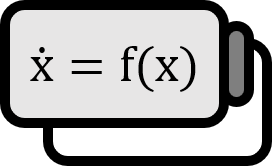Smooth Systems in Each Segment of Dynamics
Definition
Piecewise Smooth System
Let’s consider a dynamical system whose state space is $\mathbb{R}^{n}$ with variables $x \in \mathbb{R}^{n}$ and parameters $\mu \in \mathbb{R}^{p}$ represented as follows:
$$
\dot{x} = f \left( x ; \mu \right) \qquad x \in \mathbb{R}^{n} , \mu \in \mathbb{R}^{p}
$$
If there exist finitely many open sets $S_{k} \subset \mathbb{R}^{n}$ and $f$ that satisfy the following for smooth functions $F_{k} : S_{k} \to \mathbb{R}^{n}$, then this system is called a Piecewise Smooth System:
$$
f \left( x , \mu \right) = F_{k} \left( x , \mu \right) \qquad \forall (x,\mu) \in S_{k} \subset \mathbb{R}^{n}
$$
The region $\Sigma_{ij}$ between $S_{i}$ and $S_{j}$ is assumed to be a $(n-1)$-dimensional differential manifold, and $F$ may implicitly represent a multivalued map, not strictly a function in the traditional sense.
Degree of smoothness
Considering sufficiently smooth $F_{i}$ and $F_{j}$,
$$
F_{i}^{(k)} - F_{j}^{(k)} = {{ d^{k} } \over { d x^{k} }} F_{i} - {{ d^{k} } \over { d x^{k} }} F_{j}
$$
there exists an integer $d \ge 0$ such that for all $k$ that satisfy $0 \le k < d$, if $\left( F_{i}^{(k)} - F_{j}^{(k)} \right)$ is continuous in $\Sigma_{ij}$ and $\left( F_{i}^{(d)} - F_{j}^{(d)} \right)$ is not, then $d$ is referred to as the Degree of smoothness in $\Sigma_{ij}$.
Explanation 1
Many theories in dynamics have developed alongside the history of ordinary differential equations, primarily focusing on smooth functions. However, practical applications (especially in control) tend to break these conventions. PWS offers a transitional view before exploring mature non-smooth systems. Though its definition might be somewhat vague mathematically, its expression is clear and communicates well, making it acceptable for use. A famous example is the DC-DC buck converter represented as follows:
$$
\begin{align*}
\dot{V} =& - {{ 1 } \over { RC }} V + {{ I } \over { C }}
\\ \dot{I} =& - {{ V } \over { L }} + \begin{cases}
0 & , \text{if } V \ge V_{r} (t)
\\ E / L & , \text{if } V < V_{r} (t)
\end{cases}
\\ V_{r} (t) =& \gamma + \eta \left( t \mod T \right)
\end{align*}
$$
This system is evidently non-smooth, but whether or not it conforms to the definition of PWS is not of significant importance.
Degree of smoothness
Though typically translated as “Degree,” in this context, it closely matches the concept of Degree of smoothness. Simply put, it explains how many times $\dot{x} = f(x)$ needs to be differentiated before discontinuities arise. The reference literature states that in
$$
\dot{x} = - \sign x
$$
$\Sigma_{12} = \left\{ x = 0 \right\}$ is $d = 0$ and in
$$
\dot{x} = - \left| x \right|
$$
$\Sigma_{12} = \left\{ x = 0 \right\}$ is $d = 1$. Similarly, these assertions are not derived from meticulous consideration of the definition of the sign function $\sign$ or the differentiability of absolute value. It’s more intuitive to understand and move on.
Di Bernardo, M., Budd, C. J., Champneys, A. R., Kowalczyk, P., Nordmark, A. B., Tost, G. O., & Piiroinen, P. T. (2008). Bifurcations in nonsmooth dynamical systems. SIAM review, 50(4), 629-701. https://doi.org/10.1137/050625060: p632~635. ↩︎
